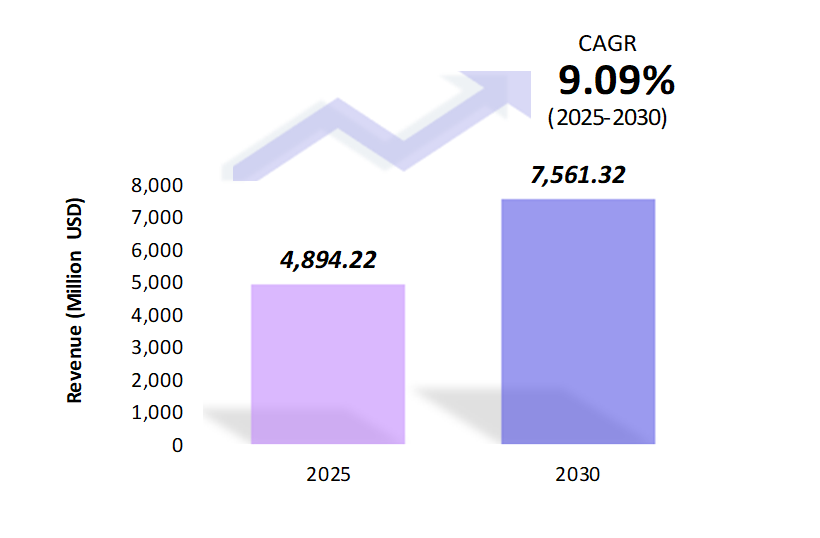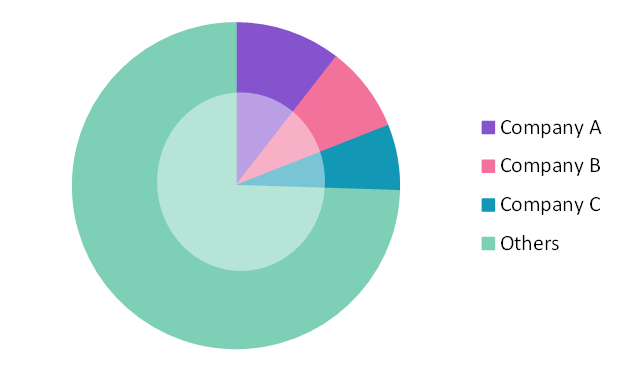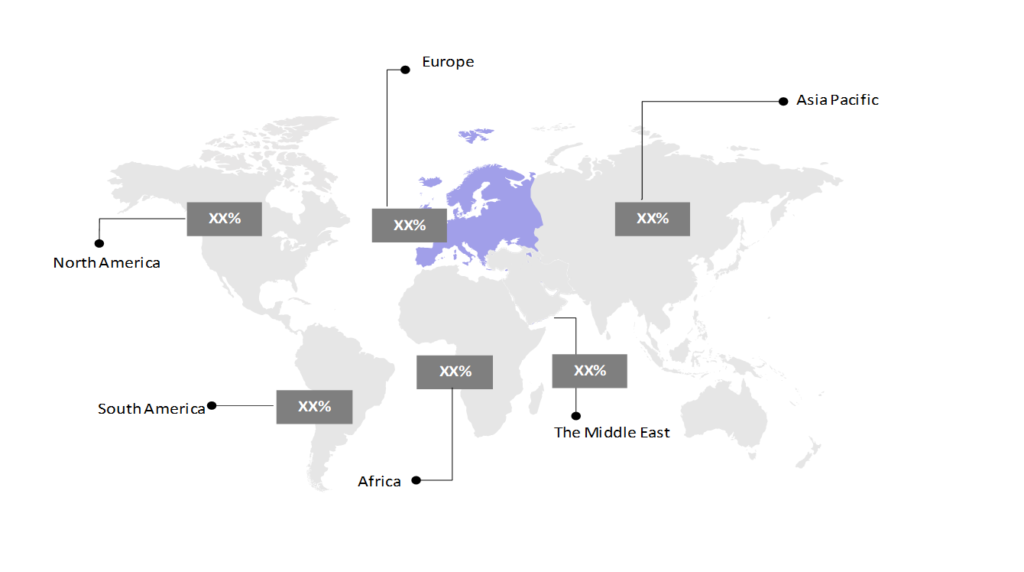Glider Aircraft Market Analysis: Growth, Size, Share & Future Trends (2024-2029)
The market report offers a detailed analysis segmented by Type (Sailplane, Hang Glider); by Application (Commercial, Military, Others); by Geography (North America, South America, Asia Pacific, Europe, The Middle East, Africa).
Outlook

- The glider aircraft market is estimated to be at USD 4,894.22 Mn in 2025 and is anticipated to reach USD 7,561.32 Mn in 2030.
- The glider aircraft market is registering a CAGR of 9.09% during the forecast period 2025-2030.
- The glider aircraft market is experiencing growth driven by increasing interest in recreational flying and advancements in sustainable aviation technologies. Innovations such as electric self-launching gliders and solar-powered designs are attracting environmentally conscious consumers and aviation enthusiasts. Overall, the market is evolving towards more efficient, eco-friendly solutions that cater to both individual pilots and training institutions.
Request a free sample.
Ecosystem

- The participants in the global glider aircraft industry are always developing their strategies to preserve a competitive advantage.
- Smaller, regional manufacturers often cater to specific market segments, such as training gliders or specialized competition models, which allows them to carve out niche markets and compete effectively against larger companies.
- Several important entities in the glider aircraft market include Albatross Flying Systems Pvt. Ltd.; Schempp-Hirth Flugzeug-Vertriebs GmbH; Lange Aviation GmbH; DG Aviation GmbH; Textron Inc. (Pipistrel); and others.
Ask for customization.
Findings
| Attributes | Values |
|---|---|
| Historical Period | 2019-2023 |
| Base Year | 2024 |
| Forecast Period | 2025-2030 |
| Market Size (2025) | USD 4,894.22 Mn |
| Market Size (2030) | USD 7,561.32 Mn |
| Growth Rate | 9.09% CAGR from 2025 to 2030 |
| Key Segments | Type (Sailplane, Hang Glider); Application (Commercial, Military, Others); Geography (North America, South America, Asia Pacific, Europe, The Middle East, Africa) |
| Key Vendors | Albatross Flying Systems Pvt. Ltd.; Schempp-Hirth Flugzeug-Vertriebs GmbH; Lange Aviation GmbH; DG Aviation GmbH; Textron Inc. (Pipistrel) |
| Key Countries | The US; Canada; Mexico; Brazil; Argentina; China; India; Japan; South Korea; The UK; Germany; Italy; France; Switzerland; Qatar; UAE; Saudi Arabia; Egypt; South Africa |
| Largest Market | Europe |
Get a free quote.
Trends
- Development of Electric-Powered Self-Launching Gliders: Self-launching gliders equipped with electric motors are becoming increasingly popular, which allows pilots to take off without the need for an external tow plane. These electric systems are quiet, environmentally friendly, and require less maintenance compared to traditional combustion engines. The Lange Antares 20E glider uses an electric motor for self-launching, which provides an extended flight range and reduces dependence on the use of traditional aerotowing.
- Advanced Composite Materials for Lightweight Structures: Innovations in materials, particularly carbon fiber and other advanced composites, are leading to stronger yet lighter glider structures. These materials improve the aerodynamic efficiency of gliders, which allows for longer flight times and greater maneuverability without sacrificing durability.
- Integration of Advanced Avionics and Navigation Systems: The adoption of advanced avionics, including GPS-based navigation systems, variometers, and electronic flight instruments, is making glider flights safer and more efficient. These systems provide real-time data on altitude, speed, lift zones, and weather conditions, which allows pilots to optimize flight paths and improve overall flight efficiency.
Speak to analyst.
Catalysts
- Growing Popularity of Recreational Aviation: The increasing interest in recreational flying, particularly among aviation enthusiasts, is driving demand for glider aircraft. Gliding offers a unique flying experience without the complexity of powered aircraft, which makes it a popular choice for leisure and sport aviation. The rise of gliding clubs, competitions, and tourism activities centered around gliding further boosts the market’s growth.
- Increasing Focus on Sustainable Aviation: As the aviation industry looks for ways to reduce carbon emissions, glider aircraft are gaining attention for their minimal environmental impact. Gliders rely on natural lift for sustained flight, which makes them an eco-friendly alternative. This focus on sustainability is encouraging both private users and training institutions to invest in gliders as a green aviation option. The SolarStratos project initiative aims to demonstrate the potential of solar-powered flight by developing a solar-electric glider capable of reaching the stratosphere.
- Rise Use in Pilot Training and Skill Development: Glider aircraft play a crucial role in pilot training, offering a cost-effective and foundational way to develop core aviation skills such as navigation, aerodynamics, and maneuvering without powered engines. Many flight schools and military programs use gliders for initial training, contributing to steady demand in this segment of the market. This factor is further supported by a growing demand for skilled pilots in both commercial and private aviation sectors.
Inquire before buying.
Restraints
- High Initial Purchase and Maintenance Costs: The upfront costs associated with acquiring glider aircraft can be significant, particularly for advanced models equipped with the latest technologies. Additionally, ongoing maintenance and operational expenses can deter potential buyers, especially in a market where budget constraints are common. This financial barrier can limit access to gliders for recreational pilots and flying clubs, impacting overall market growth.
- Limited Infrastructure and Support: The availability of adequate infrastructure, such as launch sites, maintenance facilities, and training schools, can be a challenge for the glider market. In many regions, the lack of supportive infrastructure can hinder the growth of gliding activities and discourage potential pilots from pursuing this form of aviation. Establishing and maintaining these facilities requires investment, which may not be feasible in areas with lower gliding activity.
- Weather Dependency and Operational Limitations: Glider aircraft rely heavily on weather conditions for sustained flight, which makes them vulnerable to environmental factors such as wind patterns, thermal activity, and precipitation. This dependency can limit flying opportunities, especially in regions with less favorable weather conditions or during certain seasons. As a result, glider pilots may face challenges in maximizing their flight time, which can affect overall satisfaction and participation in the sport.
Personalize this research.
Hotspot

Explore purchase options.
Table of Contents
| 1. Introduction 1.1. Research Methodology 1.2. Scope of the Study 2. Market Overview / Executive Summary 2.1. Global Glider Aircraft Market (2019 – 2023) 2.2. Global Glider Aircraft Market (2024 – 2030) 3. Market Segmentation 3.1. Global Glider Aircraft Market by Type 3.1.1. Sailplane 3.1.2. Hang Glider 3.2. Global Glider Aircraft Market by Application 3.2.1. Commercial 3.2.2. Military 3.2.3. Others 4. Regional Segmentation 4.1. North America 4.1.1. The US 4.1.2. Canada 4.1.3. Mexico 4.2. South America 4.2.1. Brazil 4.2.2. Argentina 4.2.3. Rest of South America 4.3. Asia Pacific 4.3.1. China 4.3.2. India 4.3.3. Japan 4.3.4. South Korea 4.3.5. Rest of Asia Pacific 4.4. Europe 4.4.1. The UK 4.4.2. Germany 4.4.3. Italy 4.4.4. France 4.4.5. Switzerland 4.4.6. Rest of Europe 4.5. The Middle East 4.5.1. Qatar 4.5.2. UAE 4.5.3. Saudi Arabia 4.5.4. Rest of the Middle East 4.6. Africa 4.6.1. Egypt 4.6.2. South Africa 4.6.3. Rest of Africa 5. Value Chain Analysis of the Global Glider Aircraft Market 6. Porter Five Forces Analysis 6.1. Threats of New Entrants 6.2. Threats of Substitutes 6.3. Bargaining Power of Buyers 6.4. Bargaining Power of Suppliers 6.5. Competition in the Industry 7. Trends, Drivers and Challenges Analysis 7.1. Market Trends 7.1.1. Market Trend 1 7.1.2. Market Trend 2 7.1.3. Market Trend 3 7.2. Market Drivers 7.2.1. Market Driver 1 7.2.2. Market Driver 2 7.2.3. Market Driver 3 7.3. Market Challenges 7.3.1. Market Challenge 1 7.3.2. Market Challenge 2 7.3.3. Market Challenge 3 8. Opportunities Analysis 8.1. Market Opportunity 1 8.2. Market Opportunity 2 8.3. Market Opportunity 3 9. Competitive Landscape 9.1. Albatross Flying Systems Pvt. Ltd. 9.2. Schempp-Hirth Flugzeug-Vertriebs GmbH 9.3. Lange Aviation GmbH 9.4. DG Aviation GmbH 9.5. Textron Inc. (Pipistrel) 9.6. Company 6 9.7. Company 7 9.8. Company 8 9.9. Company 9 9.10. Company 10 |
Know the research methodology.
Glider Aircraft Market – FAQs
1. What is the current size of the glider aircraft market?
Ans. In 2025, the glider aircraft market size is USD 4,894.22 Mn.
2. Who are the major vendors in the glider aircraft market?
Ans. The major vendors in the glider aircraft market are Albatross Flying Systems Pvt. Ltd.; Schempp-Hirth Flugzeug-Vertriebs GmbH; Lange Aviation GmbH; DG Aviation GmbH; Textron Inc. (Pipistrel).
3. Which segments are covered under the glider aircraft market segments analysis?
Ans. The glider aircraft market report offers in-depth insights into Type, Application, and Geography.
